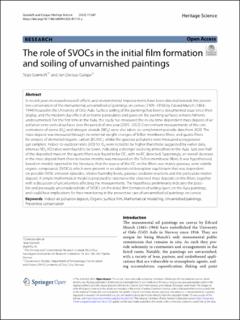| dc.description.abstract | In recent years increased research efforts and environmental improvements have been directed towards the preventive conservation of the monumental, unvarnished oil paintings on canvas (1909–1916) by Edvard Munch (1863–1944) housed in the University of Oslo Aula. Surface soiling of the paintings has been a documented issue since their display, and the modern-day effect of air-borne particulates and gases on the painting surfaces remains hitherto undocumented. For the first time in the Aula, this study has measured the in-situ time-dependent mass deposit of air pollution onto vertical surfaces over the period of one year (2021–2022). Concomitant measurements of the concentrations of ozone (O3) and nitrogen dioxide (NO2) were also taken, to complement periodic data from 2020. The mass deposit was measured through incremental weight changes of Teflon membrane filters, and quartz filters for analysis of elemental/organic carbon (EC/OC), whilst the gaseous pollutants were measured using passive gas samplers. Indoor-to-outdoor ratios (I/O) for O3 were noted to be higher than those suggested by earlier data, whereas NO2 I/O ratios were found to be lower, indicating a stronger oxidising atmosphere in the Aula. Just over half of the deposited mass on the quartz filters was found to be OC, with no EC detected. Surprisingly, an overall decrease in the mass deposit from three to twelve months was measured on the Teflon membrane filters. It was hypothesised, based on models reported in the literature, that the source of the OC on the filters was mainly gaseous, semi-volatile organic compounds (SVOCs), which were present in an adsorption/desorption equilibrium that was dependent on possible SVOC emission episodes, relative humidity levels, gaseous oxidative reactions and the particulate matter deposit. A simple mathematical model is proposed to rationalise the observed mass deposits on the filters, together with a discussion of uncertainties affecting the measurements. The hypothesis preliminarily indicates the possible and previously unconsidered role of SVOCs on the initial film formation of soiling layers on the Aula paintings, and could bear implications for their monitoring in the preventive care of unvarnished oil paintings on canvas. | en_US |

